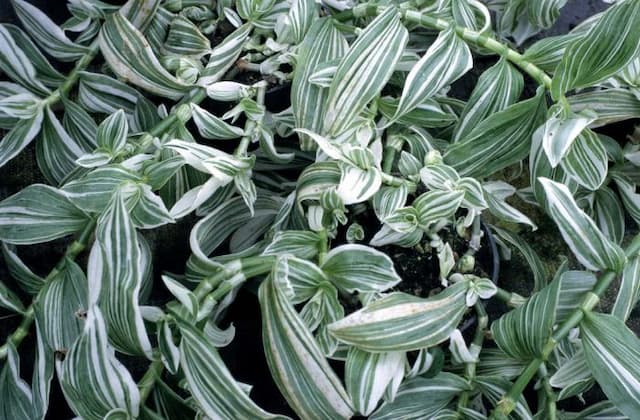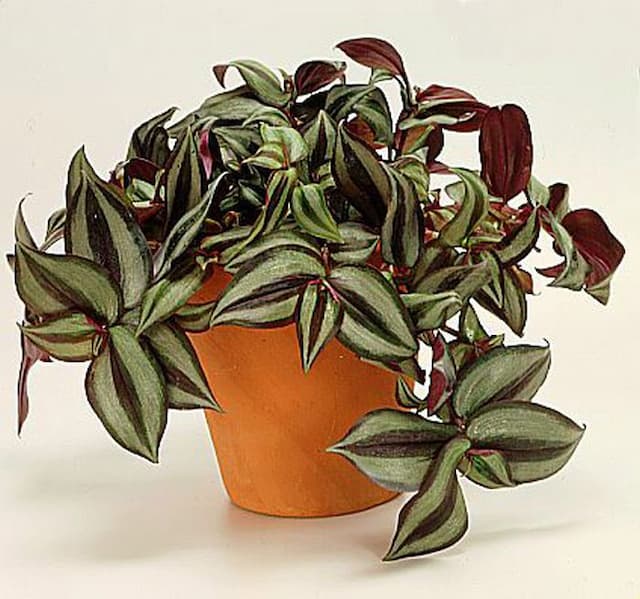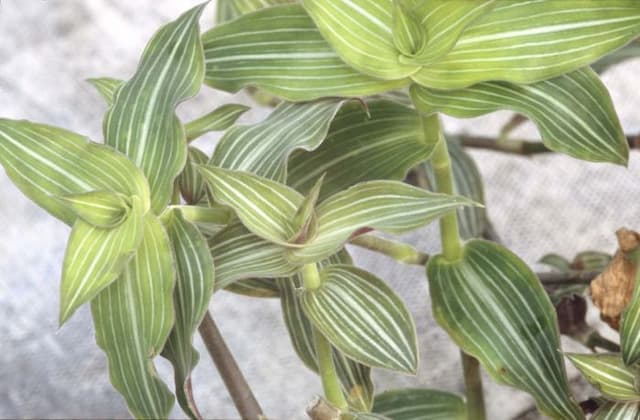Wandering Jew Tradescantia zebrina 'Purpusii'

ABOUT
The plant known commonly as Wandering Jew has a striking appearance characterized by its colorful, shimmery foliage. 'Purpusii' is a variety that boasts leaves with deep purple undersides and a pattern on the surface that combines silver, green, and purple hues. The leaves are elongate with pointed tips and exhibit a sheen which gives them a metallic look. This variety has a tendency to cascade, making it popular as a hanging basket or ground cover in the right conditions. Wandering Jew is known for growing quickly under optimal circumstances, with its stems developing roots at the nodes where they contact soil, allowing the plant to spread with ease.
About this plant
 Names
NamesFamily
Commelinaceae.
Synonyms
Wandering Jew, Inch Plant, Spiderwort, Purple Zebrina, Silver Inch Plant.
Common names
Zebrina pendula 'Purpusii', Tradescantia purpusii, Tradescantia pendula 'Purpusii'.
 Characteristics
CharacteristicsLife cycle
Perennials
Foliage type
Evergreen
Color of leaves
Variegated
Height
6 inches (15 cm)
Spread
1 foot (30 cm)
Plant type
Herb
Hardiness zones
9
Native area
Mexico
Benefits
 General Benefits
General Benefits- Easy to care for: Tradescantia zebrina 'Purpusii' requires minimal maintenance, making it great for beginners or those with a busy lifestyle.
- Fast-growing: Quickly produces lush foliage, providing an almost instant visual impact and fulfilling the desire for a fast-growing houseplant.
- Propagates easily: Stem cuttings root readily in water or soil, making it simple to create more plants for friends and family.
- Attractive foliage: The plant's striking purple, green, and silver variegated leaves add a splash of color to any room or garden.
- Trailing habit: Its trailing growth habit makes it a perfect choice for hanging baskets and elevated planters, adding vertical interest to spaces.
- Versatile in usage: Can be grown both indoors and outdoors (in suitable climates), providing flexibility in placement and usage.
- Non-toxic to pets: It is considered non-toxic, making it a safe choice for homes with pets.
 Medical Properties
Medical PropertiesThis plant is not used for medical purposes.
 Air-purifying Qualities
Air-purifying QualitiesThis plant is not specifically known for air purifying qualities.
 Other Uses
Other Uses- Artistic Medium: Artists may use the vibrant leaves of the Wandering Jew in pressed flower art or as a natural dye for textiles and paper.
- Educational Tool: Biology teachers can use the Wandering Jew to demonstrate vegetative propagation and plant anatomy due to its easy-to-root cuttings and visible nodes.
- Photography Prop: The striking purple underleaf of the Wandering Jew can provide a stunning backdrop or subject for macro and botanical photography.
- Decorative Mulch: Dried leaves of the Wandering Jew can be used as a colorful, decorative mulch for container plants or terrariums.
- Jewelry Inspiration: Jewelry designers might draw inspiration from the Wandering Jew’s distinctive leaf pattern and coloration for designs or even incorporate actual dried leaves in eco-friendly pieces.
- Fish Tanks: Wandering Jew can be used in paludariums—aquariums that combine both water and land features—provided the leaves are kept above water as it can add a naturalistic appearance.
- Seasonal Decorations: During crafts, the Wandering Jew's vibrant foliage can be incorporated into wreaths, garlands, or centerpieces for a pop of color.
- Color Teaching Aid: The leaves of Wandering Jew, with their dual-colored nature, can be used as visual aids for teaching children about colors and patterns.
- Markers for Plant Pottery: Gardeners can employ cuttings of the Wandering Jew to mark the contents in mixed planters while waiting for slower-germinating seeds to sprout.
- Microlandscaping: The Wandering Jew can be employed in microlandscaping projects like fairy gardens due to its small scale and ability to spread quickly to fill space.
Interesting Facts
 Feng Shui
Feng ShuiThe plant_name is not used in Feng Shui practice.
 Zodiac Sign Compitability
Zodiac Sign CompitabilityThe plant_name is not used in astrology practice.
 Plant Symbolism
Plant Symbolism- Adaptability: Tradescantia zebrina 'Purpusii', commonly known as Wandering Jew, has the ability to adapt to various environments which symbolizes flexibility and resilience in life.
- Survival: This hardy plant can easily propagate and survive in different conditions, representing the ability to survive through hardships and challenges.
- Regeneration: The Wandering Jew's tendency to grow back even after being cut or damaged signifies renewal, regeneration, and the concept of bouncing back.
- Growth: Wandering Jew grows quickly and spreads across surfaces which symbolizes personal growth and expansion.
 Water
WaterWandering Jew plants, including Tradescantia zebrina 'Purpusii', should be watered regularly to maintain moist but not waterlogged soil. The top inch of soil should be allowed to dry out before watering again. Typically, watering once a week is sufficient, but this may vary depending on environmental conditions such as temperature and humidity. When watering, use enough water to saturate the soil until it begins to drain from the bottom of the pot; this is often around 16 to 32 ounces, depending on pot size. In winter, reduce watering frequency as plant growth slows.
 Light
LightWandering Jew plants thrive in bright, indirect light. Place Tradescantia zebrina 'Purpusii' near a window where it can receive plenty of light without direct sun, which can scorch the leaves. A north or east-facing window is ideal, providing the bright, diffused light this plant prefers.
 Temperature
TemperatureWandering Jew plants do well in temperatures ranging between 50°F and 80°F, making them suitable for most indoor environments. It can tolerate a minimum temperature of about 50°F but should be protected from cold drafts and drastic temperature changes. The ideal temperature range for active growth is between 65°F and 75°F.
 Pruning
PruningPrune Wandering Jew plants to encourage bushier growth and to remove any leggy or dead stems. Pinching back the tips can be done at any time of the year to help maintain a fuller appearance. Perform more extensive pruning in the spring or early summer, which is the best time for heavier trimming to rejuvenate the plant.
 Cleaning
CleaningAs needed
 Soil
SoilThe best soil mix for Inch Plant should be well-draining and rich, a combination of peat, perlite, and potting soil in equal parts. Aim for a slightly acidic to neutral pH between 6.0 to 7.0.
 Repotting
RepottingInch Plant should be repotted every 1-2 years or when it becomes root-bound. Spring or early summer is the ideal time for repotting to encourage new growth.
 Humidity & Misting
Humidity & MistingInch Plant thrives in high humidity, ideally between 50% to 70%. It is tolerant of average household humidity levels but flourishes with additional moisture.
 Suitable locations
Suitable locationsIndoor
Place Inch Plant in bright indirect light and ensure high humidity.
Outdoor
Grow Inch Plant in shade and protect from cold, ensuring high humidity.
Hardiness zone
9-12 USDA
 Life cycle
Life cycleTradescantia zebrina 'Purpusii', commonly known as the Inch Plant, begins its life cycle when a seed germinates in moist, well-drained soil, typically in the warm and humid conditions it prefers. The seedling emerges and develops into a juvenile plant with characteristic silvery and purple variegated leaves on trailing stems. As the Inch Plant matures, it enters a phase of vegetative growth, wherein it spreads horizontally and vertically by producing new shoots and leaves, while also potentially developing roots at leaf nodes that contact soil. It may produce small, three-petaled flowers, although it is primarily grown for its attractive foliage rather than for its blooms. The plant can be easily propagated through cuttings that root readily, either in water or directly in soil, thus continuing its cycle without the need for seed production. The Inch Plant does not have a distinct senescence stage as a houseplant, it can live for many years with proper care, though outdoor plants may die back in colder climates and regrow from roots or stems in the spring.
 Propogation
PropogationPropogation time
Spring-Summer
The most popular method of propagating Tradescantia zebrina 'Purpusii', commonly known as Wandering Jew, is through stem cuttings. This is most effectively done in spring or early summer when the plant is actively growing. To propagate, select a healthy stem that is about 4 to 6 inches (approximately 10 to 15 centimeters) long and snip it just below a node using clean, sharp scissors. Remove the leaves from the lower half of the cutting to prevent them from rotting when planted. The cutting can then be placed directly into moist potting soil or submerged in a glass of water until roots develop, which usually takes about a week. Once rooted, plant the cutting in its own container with fresh potting mix to grow a new Wandering Jew plant.



